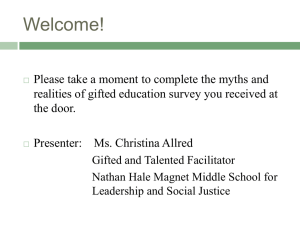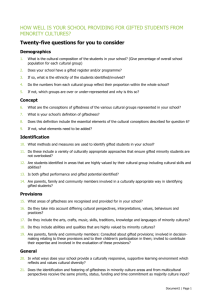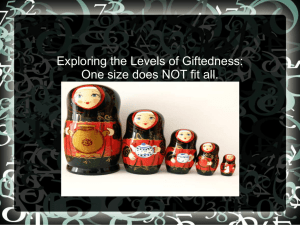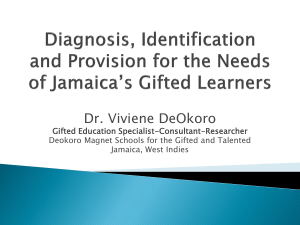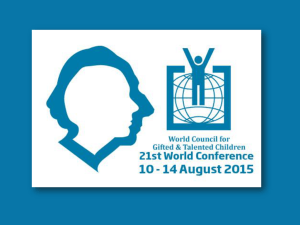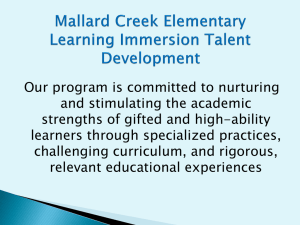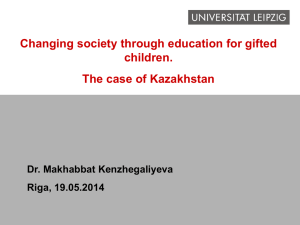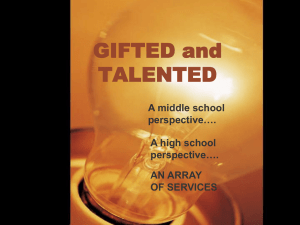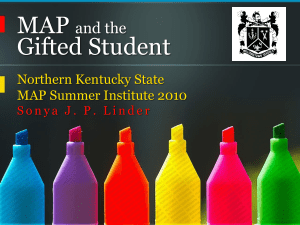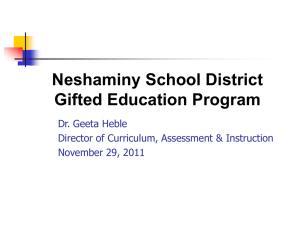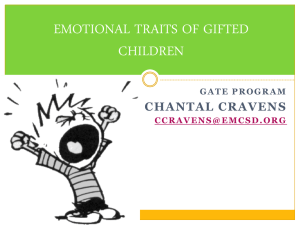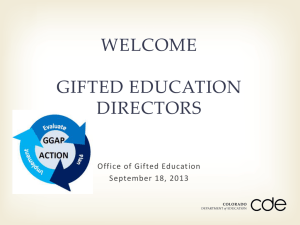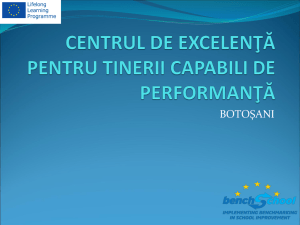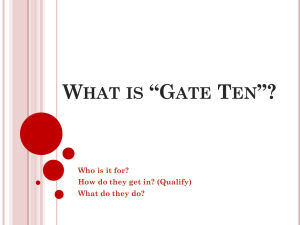Cultural Diversity & Economic Disadvantage: The
advertisement
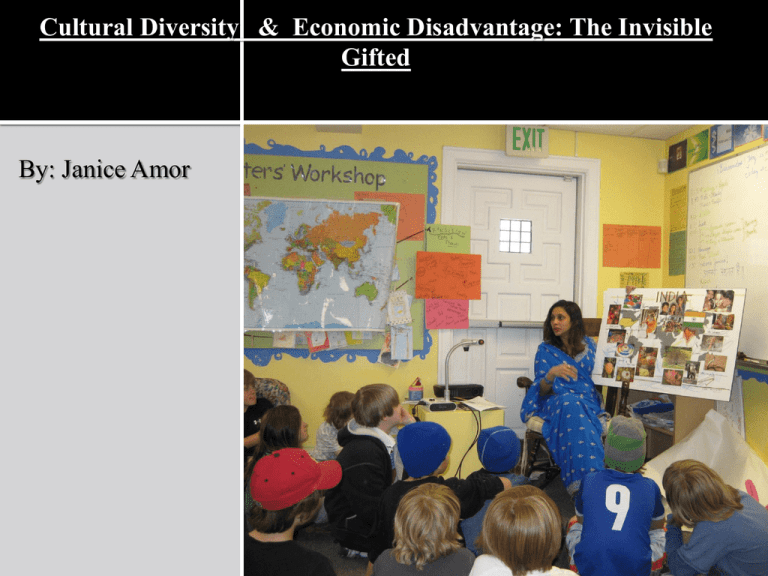
Cultural Diversity & Economic Disadvantage: The Invisible Gifted By: Janice Amor African American Hispanic American Native American Asian American and Caucasian children living in large urban centers, in underprivileged rural areas and on Indian reservations rarely are identified as G/T students. In 1977 Congresswoman Shirley Chisholm introduced legislation to include funding for G/T minority and culturally different children within Elementary and Secondary Education Act. She faulted US education for: 1. devising inadequate methods for recognizing talent among culturally different children. 2. allowing insufficient funding to provide special programs for these children. This era marked the beginning of various programs and funding for G/T minorities: 1. The Head Start program 2. Educational TV programs like Sesame Street, Barney, Dora the Explorer. 3. Bilingual-education funding 4. Desegregation All these contributed to enhancing educational opportunities and preparation. As a result the drop out rate reduced! Belief in self Personal characteristics Support systems Participation in special programs, extracurricular activities, and summer enrichment programs Appropriately challenging classes Realistic aspiration Family support Minority and culturally different gifted children are not easily identified. They often remain invisible and must be discovered or uncovered. Indeed, because of cultural bias in test instruments and other identification methods, many typical procedures actually obscure their giftedness- by providing that these children are not gifted. Identification must be based on superior potential rather than superior performance. Intelligence Tests: High intelligence test scores on either group or individual tests are one valid way to identify intellectually gifted minority youngsters. Achievement Tests: Although it is critical that achievement scores should not be misused because of cultural bias, it certainly is reasonable to use them as an index of gifts and talents for minority students. Creativity Tests: The tolerance test of creative thinking has been used in several projects with minority students. The Group Inventory for Finding (Creative) Talent (GIFT) and the Group Inventory For Finding Interests (GIFFI) are self-report inventories that evaluate personality characteristics. Matrix Identification Models: This has been developed to bring together data from a variety of sources and to specifically include variables that will help identify minority and disadvantaged gifted children. Teacher Nominations: A sensitive and caring teacher who is knowledgeable about characteristics of gifted children may, in fact be the very best identifier of the culturally different gifted children. Parent Nominations: Gifted programs should encourage parent identification. However, special efforts are necessary to educate those parents about characteristics of giftedness and the advantages of the gifted programming for their children. Peer Nominations: Peers of economically deprived or culturally different gifted children usually are aware of gifts and talents among their friends and classmates. Self Nomination: Students who believe that they are capable and who can build a case to establish their ability, interest and strong motivation should be given opportunities to demonstrate their capabilities. Quota System: A fixed percentage of culturally different children should be included in the program, calculated from the percentage of those students in the school, or district, regardless of comparative test scores or grades. As important it is to correctly identify minority students retaining them in the gifted programming is at least an equally great challenge. Thus the following components can support these disadvantaged students: •maintaining ethnic identity •providing extracurricular cultural enrichments • recognizing learning style differences and counseling • developing parent support groups, •using significant model • placing greater emphasis on enrichment and •providing for career education http://www.youtube.com/watch?v=1_5W9kHCr Bk Career education for the G/T students with lower SE, should stress the professional opportunities available and the necessary educational preparation. These students should have a realistic career education program that emphasizes the lifestyle, values, ethics, and goal that accompany that particular professional career. Since 1963, A Better Chance has been opening the door to educational opportunities for thousands of young people of color in this nation. Every year they place about 500 new students (Scholars) and support over 1,900 currently-enrolled Scholars in more than 300 of our Member Schools across the country. After graduation, these Scholars can look forward to a college degree and a real chance at making a difference in their community. • To date, A Better Chance has placed more than 12,000 middle and junior high school students in some of our nation’s finest college preparatory schools, both public and private • More than 96% of A Better Chance graduating seniors immediately enroll in college • One-third of A Better Chance Scholars come from families receiving welfare or who are living at or below the federal poverty line • 65% of A Better Chance Scholars come from single-parent families • More than 4,500 volunteers nationwide contribute their time and energy to identifying academically able children who can benefit from the A Better Chance experience • The 305 member schools of A Better Chance are distributed among 28 states • A Better Chance alumni currently reside in all 50 states • New Scholars received over $6.5 million in financial aid from Member Schools Current Students in the ABC program African American 65% Hispanic/Latino 20% Asian American 6% Multiracial 5% Other Native American 4% <1% Source: Information from http://www.abetterchance.org/abetterchance.aspx?pgID=970 0.7 0.6 0.5 0.4 0.3 Male 0.2 Female 0.1 0 1 2 3 4 Davis, Gary A. & Rimm, Sylvia B. (2010). Education of the Gifted and Talented, 6th Edition. Upper Saddle River, NJ: Prentice Hall. A Better Chance. Retrieved July 27, 2010, from http://www.abetterchance.org/abetterchance.aspx?pgID=959

